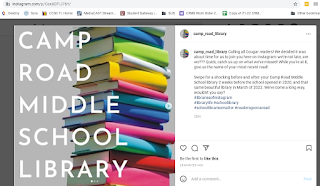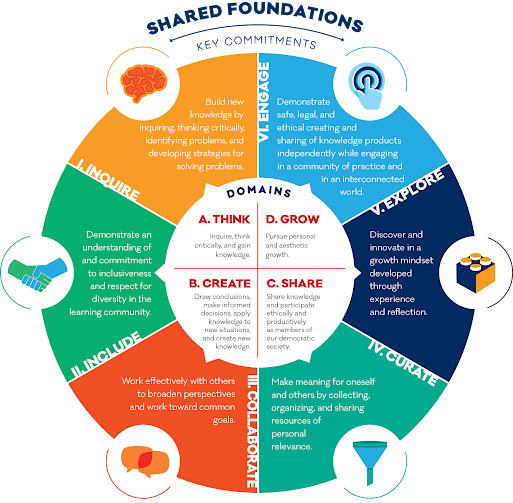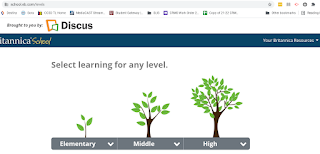Ask not what you can do for the 'gram, ask what the 'gram can do for you (Social Media as Advocacy Tool)
"Librarians and library workers who serve teens know that
staying up on trends, including those related to social media
and marketing, is just part of the job" (Wetta, 2016, p. 32).
There's a meme format with which you might be familiar: wanna feel old? This particular meme always begins the same way, but has launched countless create-your-own endings aimed at reminding their readers that something which may feel like a recent memory actually happened long ago ("long" being relative to each iteration of the meme, of course). I think it's safe to say that, in the unlikely event you do find yourself wanting to feel old, spending a few minutes with middle school students is just the ticket. Their interests, role models, fashions, inside jokes and cultural references are nearly all inspired by or integral to the online content they consume and the social media platforms they use. If you are already keeping up with the who, what, when, and wheres (can the 'why' even be understood?) kids devote their online attention these days, you are to be commended. I still refer to social media exclusively as "sosh meeds" and I have attempted to navigate TikTok exactly once. BUT! I am newly invigorated by this week's course readings and I am boldly (timidly) going where many (so many) have gone before me: I'm curating a school library Instagram account [cue victorious music].
Of the platforms from which we could choose, I felt that Instagram offers the greatest potential for interaction, promotion, and impact. I left Facebook back when it was still called Facebook, I use and value Twitter both personally and professionally, but most of the content I see is aimed at adults and published by or on behalf of big corporations. Snapchat remains popular with tweens and teens, but the fleeting nature of posts to the app means that making a lasting impression is no small feat. Conversely, Instagram's story feature offers many of the same benefits of Snapchat but without the self-destructing post drawback. I also love that the focal point of Instagram is images and videos, which allow users to capture, share, and create content instantly and effortlessly.
Taking some cues from Wetta's primer on using Instagram, I created a simple, vibrant logo for my school library profile, included photos of the library in my initial post, and incorporated a few hashtags already popularized on the platform.
I know I have a steep learning curve ahead of me, but I am starting out with a 3-pronged strategy, and a willingness to adapt as I learn! I began by following Instagram accounts from industry experts and hashtags for school library and young adult literature topics. Exploring the post topics and formats, trends in reading and instruction, and popular titles people are discussing is a fantastic way to learn how people are successfully using Instagram to engage with their followers. Hashtags like #librariansofinstagram, #yalit, #schoollibrariesmatter, and countless others are invaluable tools for plugging into discussions on new and trending topics in the sphere, as well as a great way to find new accounts worth following. Second, since the goal of the account is engagement, I will publicize the mess out of it within the library community in order to maximize the library's reach. I have downloaded an Instagram nametag, which is a QR code that viewers can scan to launch the library's page directly. We will be able to add the nametag to the weekly staff newsletter, family newsletter for students and guardians, and to flyers in the library and around the school so that finding and following the account is quick and easy. And finally, I endeavor to learn and post something new each week so that both I and the account can grow! While my learning goals are small (I do not know how to make an Instagram story, so this may be the first goal), I am committed to building my knowledge base, comfort level, and 'gram powers so that our library page gradually earns its place among the ranks of esteemed school library sosh meeds accounts.
Below are a few more ways I hope to employ the library's Instagram page to facilitate collaboration within the school, communication with library users and stakeholders, and advocacy for the needs of our library community. What others would you add?
- Following the official accounts of CRMS teachers, teams, clubs, and organizations will build or bolster connections with other educators and stakeholders
- Posting about library hours, policies, special events, and new collection materials will empower students and colleagues in making the most of library resources, driving in-person visits and opening the doors for collaborative instruction
- Sharing news about city- and statewide, national, and international celebrations of reading, writing, literacy, and libraries serves to educate followers on the latest and trending topics relevant to our services
- Scheduled student/teacher account takeovers will garner heightened interest in posts and allow followers the chance to share their own favorite reads or library resources
- Utilizing hashtags already popular on Instagram will direct more traffic to our posts and provide inspiration for creative twists on trending topics
- Monitoring analytics will provide insight into what works, whether posts served their intended purpose, and how engagement is evolving
- Current logo is admittedly somewhat basic, but this is an area of opportunity! Calls for logo ideas and submissions with an opportunity to vote on the final version would invite additional followers and promote interaction with the library account
References:
Valenza, J. (2015). Evolving with evidence. Knowledge Quest, 43(3), 36-43.
Valenza, J. (2015). Evolving with evidence. Knowledge Quest, 43(3), 36-43.
Wetta, M. (2016). Instagram now. School Library Journal, 62(2), 30–.






Comments
Post a Comment